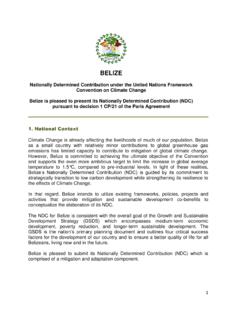Transcription of One City - nyc.gov
1 1 One CityBuilt to Last The City of New YorkMayor Bill de BlasioMayor s Office of Long-Term Planning and SustainabilityAnthony Shorris, First Deputy MayorTransforming New York City s Buildings for a Low-Carbon from the Mayor 3 Executive Summary 5 Overview 1819 Introduction24 Background33 Transforming our Buildings for 205037 A Roadmap for New York City s Buildings39 Work We Will Begin Today41 Guiding StrategiesPublic Buildings as Models for Sustainability 4446 Invest in High Value Projects in All City- Owned Buildings48 Expand Solar Power on City Rooftops49 Implement Deep Retrofi ts in Key City Facilities51 Improve Operations and Maintenance in City Buildings53
2 Pilot New Clean Energy Technology in City Buildings54 Improve the Effi ciency and Quality of New York City s Public HousingA Thriving Market for Energy Effi ciency and Renewable Energy 5658 Launch an Energy and Water Retrofi t Accelerator62 Engage Communities in Creating Energy Effi cient and Resilient Neighborhoods64 Expand Access to Information for Mid-Sized Buildings69 Provide Financing Options for Energy Effi ciency and Clean Energy Table of Contents72 Improve Energy and Water Effi ciency in Affordable Housing74 Bring Solar Power to New Neighborhoods Across New York City75 Coordinate with the State to Streamline Financing and Incentive Programs76 Collaborate with Local Utilities to Promote Energy Effi ciency78 Expand the Goals and Reach of the NYC Carbon Challenge 80 Train the Next Generation of Building Operators82 Expand NYC CoolRoofs83 Help New Yorkers Reduce Energy Use at HomeWorld Class Green Building and Energy Codes 8486 Raise the Standards for our Building and Energy Codes87 Enhance Energy
3 Code EnforcementA Global Hub for Clean Energy Technology and Innovatation 8890 Explore Innovative Technologies for NYC Buildings91 Support Emerging Entrepreneurs in Clean Energy and Energy Effi ciencySummary of Impacts 94 Appendices 100101 Footnotes103 Glossary109 AcknowledgmentsRevision City Built to Last2 Letter from the Mayor3 Friends, Global climate change is the challenge of our generation. New Yorkers are facing the risks of rising sea levels, increased temperatures and heat waves, and increasing frequency of intense storms. The damage caused by Hurricane Sandy in 2012 pro-vided tragic evidence of these risks.
4 Almost two years later, we are still recovering. Globally, rising sea levels will fl ood coastlines, droughts will disrupt livelihoods, and storms and other extreme weather will threaten lives and economic develop-ment. We are faced with an existential threat, and inaction is not an option. New Yorkers will rise to the challenge. We will build on progress we have made to become more resilient to a changing climate and to mitigate the harmful greenhouse gas emissions that contribute to climate change. We are committing to reduce our emissions by 80 percent below 2005 levels by 2050, making us the largest city in the world to commit to this goal.
5 In New York City, our buildings are responsible for the overwhelming share of our emissions. The energy we use in our homes, schools, workplaces, stores, and public facilities accounts for nearly three-quarters of our contribution to climate change. But we can upgrade our buildings to make them more energy effi cient and reduce these emissions. With this work, we can make our homes more affordable, improve the quality of our air, and create a thriving market for energy effi ciency and renew-able energy with new jobs and new this ten-year plan, we are making a commitment to achieve the greenhouse gas emissions reductions needed from our buildings to put us on the path to meet our ambitious climate goal.
6 Realizing this vision will not be easy. The change will come building by building, block by block, and neighborhood by neighborhood. It will require new technologies and innovative thinking. But New Yorkers are the world s most skilled architects, engineers, real estate developers, academics, construction workers, and building op-erators. The solutions we develop together will change our city, and they can change cities across the world. Our work begins today, and working together, we can truly become One City: Built to Last. Mayor Bill de BlasioOne City Built to Last4 ExecutiveSummary5 Executive SummaryWhat does it mean for a city to be built to last?
7 In a city that is built to last, our homes and workplaces will require less energy for heating, cooling, and power. The energy those buildings will need comes from re-newable sources that do not pollute our air and water or dangerously increase global temperatures. Residents of a city built to last are protected from rising sea levels and extreme weather. Global climate change is the challenge of our generation. The stakes are high for New Yorkers and for the world. In the coming years, New York City will face rising sea levels, increased temperatures and heat waves, and an increasing frequency of the most intense storms.
8 These risks are not remote nor distant. They are here today. The damage caused by Hurricane Sandy in 2012 provided vivid evidence of these risks. Almost two years later, we are still recovering. Globally, climate change is having a devastating impact on people s lives as rising sea levels fl ood coastlines, droughts disrupt livelihoods, and storms, hurricanes, and other extreme weather events threaten security and economic development. For this reason, New York City is committed to reducing its greenhouse gas (GHG) emissions by 80 percent by 2050 the level the United Nations projects is needed to avoid the most dangerous impacts of climate change and will chart a long-term course for a total transition away from fossil fuels to renewable sources of New York City, our buildings are responsible for the overwhelming share of our GHG emissions, accounting for nearly three-quarters of our contribution to climate change.
9 We can upgrade our buildings to become more energy effi cient and power them with renewable sources of energy, reducing our GHG emissions while also helping to make our homes more affordable and creating new jobs and this vision will require engaged communities, energized leadership, and creative solutions. We will rise to the challenge. New York City is one of the world s leaders in real estate development, architecture and engineering fi rms, skilled labor unions, fi nancial institutions, and research universities. We are uniquely poised to develop the solutions needed to transform our city, and will share these solutions with the have the power to begin transforming our buildings for a low-carbon future and the complete transition away from fossil fuels and we will begin today.
10 The Global ContextHuman activities are increasing fossil fuel combustion and changing land use pat-terns, which leads to GHG emissions that change the chemical composition of the Over time, this has had a direct and measurable impact on human populations and natural ecosystems. One City Built to Last6 The United Nations Framework Convention on Climate Change (UNFCCC) proj-ects that by 2050, global GHG emissions must be reduced by 50 percent below 1990 levels to avoid the most dangerous impacts of climate change. Developed coun-tries must reduce their emissions even more aggressively by up to 80 percent by 2050 to account for their greater contribution to global emissions to date and their higher than average per-capita emissions.















